We’ve covered grammar a few times in the past, but as I’m in the middle of writing the grammar chapter in my book, this might be a nice opportunity to go through grammar in some depth.
Grammar is a storytelling machine. It takes in a few actors, picks an action, and sets a story in motion. Every piece of obnoxious grammatical jargon (the pluperfect passive indicative, the genitive case, the subordinate clause) is just a different way to tell a story. And we tell all sorts of stories, which is why grammar books tend to be long. Even with just three actors – myself, dog, cookie – the possibilities are almost endless: I will feed my dog a cookie, My dog feeds me a cookie, A cookie fed me to my dog, etc.
Every grammatical story has a few necessary ingredients. We need to know the roles of every player in our sentence (I feed my dog a cookie, My dog feeds me a cookie), and we need to know precisely how, when and whether the action takes place (I feed my dog daily, I fed my dog last night, I would have fed my dog…).
Each of these stories has a different grammatical form, and while grammar has a lot of possible forms, it makes each of these forms using only three basic operations: it can move words (It is done -> Is it done?), it can change words (I eat hamburgers -> I ate hamburgers) and it can add words (You like cats -> Do you like cats?). Every single grammatical form is just a combination of one or more of these three operations.
So to learn grammar, we just need to break down each form we encounter into its components. On the surface, we’re just going to memorize a bunch of sentences, but because we’re breaking these sentences down into tiny, single-operation chunks, we can get a lot of mileage out of each sentence we encounter.
The procedure is relatively simple: First, find an example sentence. The easiest source for these is a grammar book, because it’s already arranged in order of complexity. Second, make sure you understand that sentence. You can use translations here; we’re going to get rid of them when we turn this sentence into flashcards. Within a couple of weeks, you’ll forget the translations and retain the meaning of the words and grammar in your target language. Once you’ve fully understood out the meaning of your sentence, you’ll learn the basic vocabulary, learn any changes in word formation, and learn the word order.
Let’s go through an example:
- Find an example sentence: I fed my dog a cookie.
- Make sure you really understand it. Who’s doing what to whom? When is the action taking place? Is this a real event, or something hypothetical, like “I would have fed my dog” or “I could have fed my dog..”? Does this sentence just tell a story or does it also convey some weird emphasis? “My dog was fed a cookie by me,” for example, is a story about something that happened to my dog rather than a story about something I did.
- Learn the basic vocabulary. When I say ‘basic,’ I mean these words: I, to feed, dog, a, cookie. We need flashcards for all of these, and translations aren’t allowed, so let’s look at what these look like:
Four of these are relatively easy. You can just use pictures:


I to feed


dog cookie
Assuming all of these words are totally new to you, you’ll make 4-8 flashcards (Word - Picture, Picture - Word) for each of these words. You can find the base forms (to feed, for example) in your dictionary. Because you’re the one making them, you’ll remember that the verb you’re learning is “to feed” rather than “to eat,” and that the picture of the guy pointing to himself is “I,” rather than “He” or “Man.”
Now things get interesting. What does “a” mean, and how do we make a flashcard for it? If you did step #2, then you understand the whole story. You know that you had a cookie (There was no previously mentioned cookie, so we’re not using “the cookie”), you gave it to your dog, and he ate it. While “a” basically means “one” (in fact, that’s where it came from in old English), that’s not how we’re going to remember it. Instead, we’re going to remember the following definition: “a” is the word that fits into this sentence: I fed my dog __ cookie.
We’ll make two flashcards, which look like this:
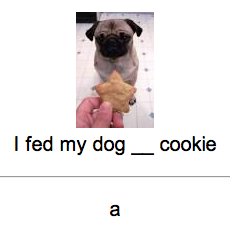
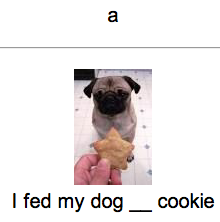
When you review flashcard #1, you just need to supply the word “a.” When you review flashcard #2, you don’t need to spit out the whole sentence; you just need to remember that “a” is the word that goes before “cookie” in a sentence like that. It’s a fuzzy definition, and that’s OK. In time, as you encounter more sentences that use “a,” your brain will get a better sense for when and where it’s used, but your “a” will start with your dog and his cookie. Cards like these only work when you make them yourself. After all, you’re the one who’s spent time playing around with this sentence, so you’re the only one who’s going to benefit from this little reminder of what you’ve learned.
We’ll always use pictures, because they make memorization much easier. Even if our sentence is relatively abstract (Programming can be a complex endeavor), we’ll use some picture that’s vaguely related to the content of the sentence (i.e., a computer, or a programmer, or a blackboard full of equations).
What about “my”? We could learn “my” in the same way as we learned “a,” but we’re going to learn it in a different way. “My” is just what happens when you combine “I + Dog,” and we already know those two words. So we’ll learn “my” in the next step, when we play around with word formation.
- Learn any changes in word formation. Here’s where we learn “fed” and “my.”
To learn changes in word formation, we’ll give ourselves the example sentence and the root form of the word, like this:
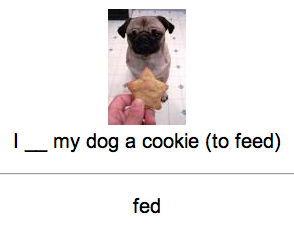
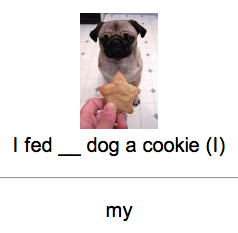
- Word order time. We need to know where each unit of the sentence goes. We’ll take a few chunks out of the sentence and try to reassemble them. These flashcards look like this:
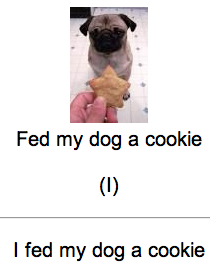
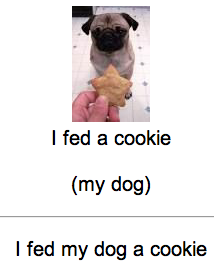
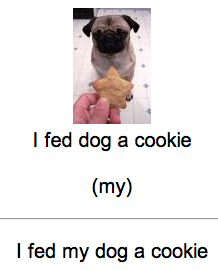
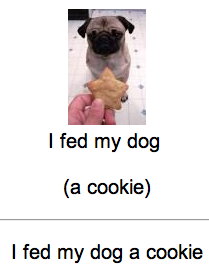
These are four possible options (out of eight or so). If I were just starting with English, I might use this many (or perhaps even a couple more). If I’ve already learned a few sentences, 2-3 word order cards will be enough to help me remember where to place my objects, or whether “my” goes before or after “dog,” etc.
Because of the way all of these cards direct your attention to the various parts of the sentence, you get a great deal of mileage out of them. Any time you write or encounter a new sentence and need to figure out who’s doing what to whom, or whether the action is occurring in the present or past, you’ll automatically recall the appropriate part of this dog/cookie story. If you do this with a few good sentences from each chapter in your grammar book, you’ll often find that when your book introduces you to a “new” concept, you already know something about it, because you’ve learned it from an earlier sentence.
Try it out and see how you like it. If something’s unclear, please ask about it in the comments.
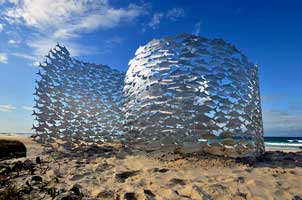
Pingback: Translated Google Image links for Language Learning (New, easier setup) | Tower of Babelfish
Hello Gwyner,
I think this will be a great way to study the more abstract words which seem difficult for me to understand how to use. One thing I am wondering is whether I should try to make flash cards for these abstract words by themselves as well as making the sentences? I’m learning a slavic language and they have more prepositions than we have in English. Each one is used under specific conditions that makes it difficult to make flash cards out of. I’ve used the preposition images that is on another blog post but my wife, who is a native speaker of Slovak, told me that those images won’t work well in Slovak. I made them anyway because I figured it was better than having nothing. Do you have any recommendations for this?
If I give you an example, it may help to explain what I’m trying to say if its unclear:
The preposition “for” in English can be listed as the following in Slovak: pre, za, na, o, k, do, po (and I think there are more). I wouldn’t know how to make flash cards for each of these words because they each have their own specific use according to how sentences are contructed.
Especially when it comes to prepositions, translations are basically useless. Cards like “a” -> “I fed my dog __ cookie” are the best you can do (and they work very well). Once you have one pair of cards for a given concept (“a” - “I fed my dog __ cookie” and “I fed my dog __ cookie” – “a”), then you can keep adding cards (“It was __ very long day” - “a”, “I took __ look at her car” - “a”) until you’re comfortable with that word.
Ok wonderful thank you!
By the way, I found this online (for Slovak) and thought you or others may want to know about this:
http://slovake.eu/sk/learning/grammar/classes/classes/prepositions
Pingback: 8 Ways to Create Better Flashcards
Pingback: Is there a more efficient way to learn vocabulary?
Thanks for your site. It’s great! One question on these cards - I’m studying Croatian- would I make these types of cards, for pronouns/grammar in Croatian then? So that it’s not “I fed __ dog”, but rather “Ja hranio ___ pas”
And do I do all sentence flashcards in the language I’m learning, avoiding English completely?
Yup, no English on any of your cards.
Thanks very much!
I just found your site through LIfeHacker and have to say that I’m impressed with your method. I’m on my fifth language (reading ability for the most part - some are no longer spoken) and have used Anki for over five years - it’s great. I have never used your immersion method with flash cards, though. I’m trying to switch over for my current language study (German) and am curious what you do with words such as interrogative pronouns (Who? What? Where?) and words that seem to have 4+ synonyms (like “auß”). Thanks again for putting everything that you have learned from experience up in a place where so many of us can learn from it.
Hi Brian. Thanks for your kind words!
For interrogative pronouns (and prepositions like aus), I keep doing fill in the blanks:
Front side, card type 1:
___ ate your homework?
[Picture of dog, eaten homework, teacher, whatever]
Back side, card type 1: “who”
Front side, card type 2:
“who”
Back side, card type 2:
___ ate your homework?
[Picture of dog, eaten homework, teacher, whatever]
Note that your job in card 2 is to remember *any* context that would be appropriate for the word. As your language builds, you might think of “Who are you dating?” or “Who is that over there?”, and that’s just fine.
If you want to deal with a word with many definitions, just keep adding cards that look like card type 1:
Front side:
That’s the girl __ is standing on the left.
[Picture of girl]
Back side:
“who”
Occasionally, you’ll run into words that don’t seem to work for this, because they need a bit of extra information:
He is a/an __ person.
[Picture of a guy]
If you’re trying to learn the word for “honest,” this might not cut it. You can fix this by choosing your sentences/pictures carefully (Abraham Lincoln was a/an __ person), or you can use monolingual definitions:
He is a/an __ person.
(He does not lie or cheat)
[Picture of a guy]
Practically, you might not be able to handle monolingual definitions in the very beginning, so you can just skip those words until you have enough vocab and grammar to learn them. I tend to learn ~600 words through pictures alone, then another 500-1000 through example sentences and pictures, and then learn the rest of my vocabulary through example sentences, pictures and definitions.
Gabriel: Thanks for taking so much time to type out that thorough explanation. It is very, very helpful.
Thanks for this really helpful article.
How would you recommend making cards like this for multiple verb tenses? Would you write the tense as part of the question?
e.g. I ___ my dog a cookie (to feed, past)